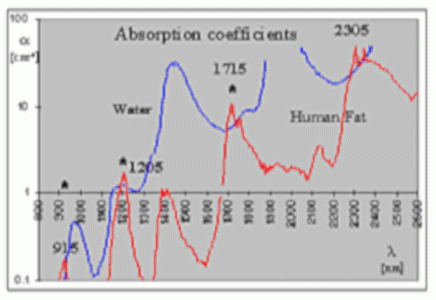Photodynamic Therapy

Fig. 1. Fat and water have nice colors in the infrared.
Additional Links
The Jefferson Lab Free-Electron Laser was used by Rox Anderson’s group from the Wellman Center at Massachussetts General Hospital, part of Harvard Medical School, for a series of experiments aimed at curing acne, a debilitating disease of over-active sebaceous glands. Currently the drug Accutane® (generically called isotretinion) is used to treat acne, but its side effects can be worse than the disease.
The principle behind the experiments is to tune the Jefferson Lab FEL light to a "color" or wavelength, which the sebaceous glands will absorb much more strongly than the surrounding tissue. As the fat cells heat up, they die, while the rest of the tissue is unharmed.

Fig. 2. FEL-induced photothermal excitation of porcine fat and porcine skin, normalized to FEL exposure energy (see text). Preferential heating of fat is maximum at the lipid absorption band maxima near 1,210 nm (A) and 1,720 nm (B). The data are consistent with water as the dominant absorber in skin and lipid as the dominant absorber in fat.
The initial experiments were successful but required carefully controlled conditions, with the skin held under a cold window, and with careful selection of the wavelength.
R. Rox Anderson, William Farinelli, Hans Laubach, Dieter Manstein, Anna N. Yaroslavsky, Joseph Gubeli III, Kevin Jordan, George R. Neil, Michelle Shinn, Walter Chandler, Gwyn P. Williams, Steven V. Benson, David R. Douglas, H.F. Dylla, "Selective photothermolysis of lipid-rich tissues: A free electron laser study", Lasers in Surgery and Medicine 38 913 (2006).

